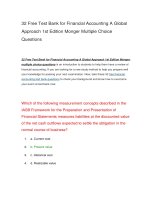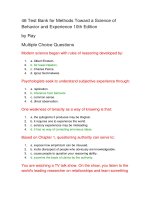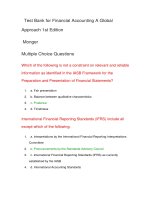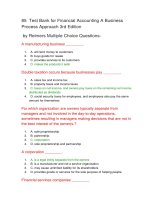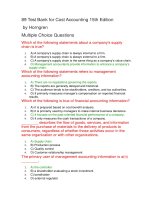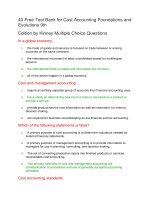57 test bank for cost management a strategic emphasis 5th
Bạn đang xem bản rút gọn của tài liệu. Xem và tải ngay bản đầy đủ của tài liệu tại đây (91.63 KB, 18 trang )
57 Test Bank for Cost Management A Strategic
Emphasis 5th .
Edition by Blocher
Mulitple Choice Questions
The five steps for strategic decision making include all of the
following except:
1.
A. Identify the alternative actions
2.
B. Gather, summarize, and report accounting information
3.
C. Determine the strategic issues surrounding the problem
4.
D. Choose and implement the desired alternative
5.
E. Provide an ongoing evaluation of the effectiveness of implementation
Management accounting information plays a critical role in all of
the following management functions except:
1.
A. Profit planning.
2.
B. Executive compensation.
3.
C. Planning and decision making.
4.
D. Hiring a new CFO.
5.
E. Preparing financial statements for the SEC.
The Institute of Management Accountants' standards of ethical
conduct for management accountants includes the elements of:
1.
A. Competence, confidentiality, integrity, and relevance.
2.
B. Competence, confidentiality, integrity, and credibility.
3.
C. Competence, confidentiality, independence, and objectivity.
4.
D. Competence, accuracy, integrity, and independence.
Which of the following is not a contemporary management
technique used by the management accountant to respond to the
changing business environment?
1.
A. Enterprise risk management
2.
B. Lean manufacturing
3.
C. Life cycle costing
4.
D. Enterprise sustainability
Which of the following aspects of a company would not be
considered a critical success factor, for a company that competes
on differentiation?
1.
A. Cutting edge research and development.
2.
B. Excellent customer service.
3.
C. Award-winning product quality.
4.
5.
D. Continually beating competitors to the market with new, innovative
products.
E. High level of production efficiency.
Which of the following is the primary user of management
accounting information regarding business units?
1.
A. Company management.
2.
B. Investors.
3.
C. Creditors.
4.
D. Industry and governmental organizations.
In keeping with the current trend of increased strategic planning,
how have management accountants changed their use of lifecycle costing?
1.
A. They have now shifted their focus from R&D costs to marketing and
promotion costs.
2.
B. They have turned from a sole focus on manufacturing costs to a much
wider outlook, taking into account costs from the entire product life-cycle.
3.
C. They stopped looking at the entire life-cycle, and now focus their
attention on product design costs.
4.
D. Accountants don't use life-cycle costing, that task is left for the
operations manager.
A local area consulting firm is trying to increase the long-term
strategic focus of its company reports. Therefore, the firm has
decided to use the balanced scorecard. What type of new
information that the company currently doesn't use in its financial
reports, should the company include?
1.
A. Non-financial information, including customer satisfaction, innovation,
etc.
2.
B. Additional financial information, such as profitability measures and
market value.
3.
C. Product life cycle information.
4.
D. Supplemental accounting reports.
Target costing determines the desired cost for a product upon the
basis of a given competitive price such that the product will:
1.
A. Earn at least a small profit.
2.
B. Earn a desired profit.C. Earn the maximum profit.
3.
D. Break even.
4.
E. Sell the highest volume.
Strategic management can be defined as the development of a
sustainable:
1.
A. Chain of command.
2.
B. Competitive position.
3.
C. Cash flow.
4.
D. Business entity.
5.
E. Company image.
Which of the following does not represent a main focus of cost
management information?
1.
A. Strategic management.
2.
B. Performance measurement.
3.
C. Planning and decision making.
4.
D. Preparation of financial statements.
5.
E. Internal auditing and control.
The strategy map is a tool that is used
1.
A. as one of the key aspects of the contemporary management
environment
2.
B. to enhance the sustainability of the organization
3.
C. to link the perspectives of the balanced scorecard
4.
D. to organize the critical success factors of a company
5.
E. to implement strategy
When managers produce value for the customer, their orientation
consists of all the following except:
1.
A. Quality and Service.
2.
B. Timeliness of delivery.
3.
C. The ability to respond to the customer's desire for specific features.
4.
D. State of the art manufacturing facilities.
A company's management accountant is trying to improve the
way costs are allocated within the company. Currently, several
corporate expenses are grouped together and labeled
"overhead." If the accountant wanted to use activity-based costing
(ABC) to help solve the problem, what should she do?
1.
A. She should try to map the departments' costs to their cost objects, and
then charge each department based on those cost relationships.
2.
B. She should research how the company's competitors are allocating their
costs, and then implement one of those strategies.
3.
C. She should look for bottlenecks within the production process, and try to
eliminate them, thus reducing costs.
4.
D. She should examine the firm's value chain and apply target costing
before adopting ABC.
A practical example of when the theory of constraints would not
be an appropriate management technique to use would be:
1.
A. Long lines at checkout stands.
2.
B. Busy signals on Internet server sites.
3.
4.
C. One critical production process provides 60 parts/min. output, compared
with a company-wide output of 90 parts/min.
D. Balanced, fast flow of product through the plant.
According to the IMA Code of Ethics, what should a management
accountant do if a significant ethical situation can't be resolved?
1.
A. The accountant should confront the guilty party and demand the
unethical action be stopped.
2.
B. The accountant should try to rationalize and understand the position of
the other party.
3.
C. The accountant should say nothing about the matter until he or she has
retired.
4.
D. The accountant should first discuss the matter with the immediate
supervisor.
All of the following are examples of total quality management
practices except:
1.
A. Redesign of a product to reduce its parts by 50 percent.
2.
B. Reduction in the movement required in a manufacturing job.
3.
C. Separating the sales and services functions.
4.
D. Raising raw material quality standards.
5.
E. Cross-training assembly line workers to cover sick leave absences.
The difference between wholesalers and retailers is:
1.
A. Wholesalers are merchandisers that sell directly to customers whereas
retailers are merchandisers that sell to other merchandisers.
2.
B. Wholesalers are merchandisers that sell to other merchandisers
whereas retailers are merchandisers that sell directly to consumers.
3.
C. Wholesalers are merchandisers that sell directly to the government
whereas retailers are merchandisers that sell to other merchandisers.
4.
D. Wholesalers are merchandisers that sell directly to customers whereas
retailers are merchandisers that sell directly to the government.
5.
E. There is no difference between wholesalers and retailers.
In a local factory, employees are rewarded for finding new and
better ways of changing the way they work. This company is
motivating its employees to use what management technique?
1.
A. Benchmarking.
2.
B. Activity-Based Costing.
3.
C. Theory of Constraints.
4.
D. Continuous Improvement.
5.
E. Total Quality Management.
Which of the following professional certificates is considered to be
the most relevant for dealing with cost management issues?
1.
A. The CPA, which is monitored differently for each state in the U.S.
2.
B. The CMA, which is administered through the Institute of Management
Accountants.
3.
C. The CFA, since its program focuses on the broadest range of topics and
responsibilities for financial analysis.
4.
D. The CPA, CMA, and CFA are viewed as equally relevant, since all three
require an exam, as well as specific background and experience
requirements.
Which of the following aspects of the contemporary business
environment involves using statistical methods such as
regression or correlation analysis to predict consumer behavior,
to measure customer satisfaction, or to develop models for setting
prices, among other uses?
1.
A. Business Intelligence
2.
B. Target Costing
3.
C. Life Cycle Costing
4.
D. Benchmarking
5.
E. Business Process Improvement
Cost management has moved from a traditional role of product
costing and operational control to a broader strategic focus, which
places an emphasis on:
1.
A. Competitive pricing.
2.
B. Domestic marketing.
3.
C. Short-term thinking.
4.
D. Strategic thinking.
5.
E. Independent judgment.
Which of the following is not a major change in the business
environment that has affected the way many companies think
about conducting business?
1.
A. An increased focus on the customer, especially their opinions about
functionality and quality.
2.
B. A growing emphasis on globalization - new markets for products and
new competitors.
3.
C. A larger number of companies are starting to use advanced information
technologies, such as business intelligence.
4.
D. The development of improved cost management methods.
Target costing:
1.
A. Determines cost based on an expected market demand for the product.
2.
B. Determines cost based on a budget.
3.
C. Determines cost based on standard cost.
4.
D. Determines cost based upon market price and desired profit.
Cost management information typically is the responsibility of
the:
1.
A. Chief Financial Officer.
2.
B. Controller.
3.
C. Treasurer.
4.
D. Chief Information Officer.
If a firm decided to reevaluate and reorganize the way it did
business, in hopes of creating competitive advantage, by
changing or decreasing jobs, the company would be using which
of the following management technique?
1.
A. The value chain.
2.
B. Business intelligence.
3.
C. Business process improvement.
4.
D. Product reevaluation.
5.
E. Life cycle costing.
Corporate management is required to identify and solve problems
from a cross-functional view. Instead of viewing a problem as
related to a specific business function, management solves these
problems by combining skills from different functions
simultaneously. This approach is called:
1.
A. Inclusive approach.
2.
B. Integrative approach.
3.
C. Intra-function approach.
4.
D. Multilateral approach.
Which of the following is not considered part of the Institute of
Management Accountants' definition of management
accounting?
1.
A. Partnering in management decision making.
2.
B. Devising planning and performance management systems.
3.
C. Gathering, summarizing, analyzing, and providing information.
4.
D. Providing expertise in financial reporting and control.
5.
E. Assisting management in the formulation and implementation of an
organization's strategy.
57 Free Test Bank for Cost Management A Strategic
Emphasis 5th Edition by Blocher Mulitple Choice
Questions - Page 2
JCH Company conducts business in the lumber and building
products industry. Last week, JCH purchased 50 railcars of
lumber from a mill in Oregon and sold all 50 to a Home Depot
store in North Carolina. In this instance, JCH Company would
most likely be classified as a:
1.
A. Manufacturer.
2.
B. Retailer.
3.
C. Warehouse.
4.
D. Wholesaler.
If a company is working on strategic positioning, what aspect of
the firm is being developed?
1.
A. How the firm is perceived by its external environment, its competitors,
and customers.
2.
B. Where the firm's physical plants, buildings, and warehouses will be
located.
3.
C. The firm's position on important issues, such as the environment and
government regulations.
4.
D. Which competitive strategy the firm will use to achieve a sustainable
competitive advantage.
The competitive strategy in which the firm succeeds by producing
at the lowest cost in the industry is termed:
1.
A. Differentiation.
2.
B. Cost advantage.
3.
C. Price strategy.
4.
D. Cost leadership.
5.
E. Resource-based strategy.
The competitive strategy of cost leadership allows a firm to
outperform competitors by producing products or services:
1.
A. With lowered quality standards, thus reducing overall costs.
2.
B. In smaller operational units.
3.
C. At lower cost achieved by increased productivity.
4.
5.
D. With attractive added features making the product more expensive, or
"the cost leader".
E. That are heavily promoted and heavily warranted.
The national sales manager for your company has pulled you
aside and asked you to prepare an invoice for one of the
company's largest clients before the end of the fiscal year which
ends this month. This invoice will include items that have not yet
been shipped and are not planned for shipment until after this
fiscal year. What should you do in this situation?
1.
A. Invoice the client as asked by the national sales manager.
2.
B. Invoice the client since this is consistent with past transactions near
fiscal year-end.
3.
C. Contact the client and notify them that credit terms are being extended
on this invoice since the goods have not been shipped.
4.
D. Discuss this situation with your supervisor.
Which of the following aspect of a contemporary management
technique is a framework and process that organizations use to
manage the occurrence of possible events that could negatively
or positively affect the company's competitiveness and success?
1.
A. Total quality management
2.
B. Lean accounting
3.
C. The theory of constraints
4.
D. Enterprise sustainability
5.
E. Enterprise risk management
A firm that has traditionally succeeded on the basis of its
innovative products and excellent customer service has started to
place greater emphasis on reducing waste and providing its
customers with the lowest priced product. Which of the following
most accurately describes this change of competitive strategy?
1.
A. Cost leadership to differentiation.
2.
B. Focus to cost leadership.
3.
C. Differentiation to focus.
4.
D. Cost leadership to focus.
5.
E. Differentiation to cost leadership.
A potential weakness of the cost leadership strategy is:
1.
A. Cutting costs in a way that causes the firm to grow too fast.
2.
B. Deleting key features of products or services.
3.
C. Lowering productivity to ensure lower costs.
4.
D. Increasing life cycle costs.
5.
E. Increasing prices temporarily to undermine competition.
The competitive strategy of differentiation is implemented by a
firm's targeted, careful attention to a(n):
1.
A. Specific feature of the product or service.
2.
B. High efficiency level of production.
3.
C. Broad possible market.
4.
D. Aggressive competitive pricing plan.
The competitive strategy in which the firm succeeds by
developing and maintaining a unique value for the product, as
perceived by the customer, is termed:
1.
A. Differentiation.
2.
B. Specialization advantage.
3.
C. Design strategy.
4.
D. Benchmarking.
5.
E. Product Specialization.
Which of the following aspects of a contemporary management
technique requires a balancing of multiple goals?
1.
A. Target costing.
2.
B. The balanced scorecard.
3.
C. Benchmarking.
4.
D. Business process improvement.
5.
E. Enterprise sustainability.
RTP Corp. is developing a new computer processor to compete
against Intel's successful product line. RTP has already
determined the market price and the required profit margin on
each processor sold in order to be successful. Which costing
method will RTP most likely use to reduce costs and obtain the
desired results?
1.
A. Target Costing.B. Product costing.
2.
C. Relevant costing.
3.
D. Cost management.
4.
E. Life cycle costing.
With the enactment of the Sarbanes-Oxley Act of 2002, all public
companies are now required by the SEC to disclose whether or
not the company has:
1.
A. An audit committee.
2.
B. Human resources guidelines.
3.
C. A code of ethics.
4.
D. A management compensation plan.
Which of following statements is/are true concerning strategy?
1.
A. Once a firm has chosen a strategy, it is unwise to change it, even though
the company or business environment might change.
2.
B. If a firm does decide to compete on more than one strategy, it must
carefully execute both strategies to be successful.
3.
C. Since the business environment is always changing, rather than stick
constantly with one strategy, firms should pay close attention during times of
change, and adjust their strategies accordingly.
4.
D. Commodity type products are usually produced by differentiated firms.
The following problems have occurred at your company:
management seems to be making decisions based on guesses
and intuition, there's a lack of clarity concerning direction and
goals, and profitable opportunities are being missed. What is your
company suffering from?
1.
2.
3.
4.
A. A lack of strategic information; management has not determined its
strategic competitive position.
B. Managers have too much information.
C. The company is not familiar with business reengineering and value chain
analysis.
D. The company has an inappropriate mission statement.
In the current business environment, companies cannot survive
without a long-term strategy. What exactly should an effective
strategy include?
1.
A. A set of policies, procedures, and approaches to business that will result
in long-term success.
2.
B. A focus on accurate financial data, thus allowing the firm to effectively
compete in any environment.
3.
C. A focus on long-term nonfinancial information that will provide the
company with versatile management techniques capable of being used in a
wide variety of situations.
4.
D. A clear, concise mission statement, naming every product and outlining
the company's long-term goals of success.
Due in part to increased global competitiveness and changes in
management techniques and processes, what has changed about
the role of the management accountant?
1.
A. Management accountants have started to place a greater emphasis on
financial information, in hopes of ensuring continued earnings.
2.
B. Rather than to focuses solely on financial data, the role of the
management accountant has shifted to encompass more of a strategic
management perspective.
3.
C. Management accountants have devised new financial measures for
corporate success, such as the balanced scorecard and value chain
analysis.
4.
D. There has been a renewed emphasis on short-term profitability, since
product life cycles have started getting shorter.
A strategy can be best defined as:
1.
A. An effective use of the organization's resources.
2.
B. A plan for using a firm's resources to achieve sustainable goals within a
competitive environment.
3.
C. A clear and detailed statement of an organization's mission and vision.
4.
D. A plan for developing a firm's mission and vision statements.
A large company has recently been experiencing larger than
normal inventories. Management would like to implement a lean
manufacturing system to help control the company's inventories.
Which of the following is not a benefit associated with a lean
manufacturing system?
1.
A. Reduced inventories.
2.
B. Existing problems such as bottlenecks are highlighted.
3.
C. Stronger supplier relationships.
4.
D. Decreased waste.
5.
E. Better product design.
Which of the following most accurately describes what is included
in cost management information?
1.
A. Only the most up-to-date, accurate financial information available on a
firm.
2.
B. All the non-financial information about a firm researched and analyzed
for a minimum of 2 years.
3.
C. A combination of financial cost information and relevant non-financial
information.
4.
D. A detailed report outlining how management currently handles all of a
company's costs, and the changes it intends to make in the future.
Non-financial measures of operations include all the following
except:
1.
A. Stock price.
2.
B. Product quality.
3.
C. Customer satisfaction.
4.
D. Market share.
5.
E. Growth opportunities.
Which of the following is not a benefit of using a lean
manufacturing system?
1.
A. Lead times are reduced.
2.
B. Average inventory is decreased.
3.
C. Productivity is improved.
4.
D. Production operations are linked in a smooth, uninterrupted flow.
5.
E. Products, on average, have less variety.
Which area(s) of a business can be improved by using a just-intime (JIT) system?
1.
A. Production, purchasing, and delivery.
2.
B. Production only.
3.
C. Purchasing only.
4.
D. Production and purchasing only.
5.
E. A just-in-time system can be used to improve any area of a business.
Which of the following formulas best reflects target costing?
1.
A. Target cost = Firm-determined price - Desired profit.
2.
B. Target cost = Market-determined price - Desired profit.
3.
C. Target cost = Firm-determined price - Desired revenue.
4.
D. Target cost = Market-determined price - Desired revenue.
5.
E. Target cost = Firm-determined price - Market-determined price.
Many automobile and consumer electronics industries have firms
which compete using a strategy of:
1.
A. Professionalism.
2.
B. Growth.
3.
C. Cost Leadership.
4.
D. ABC costing.
5.
E. Target Costing.
Which of the following is considered to be an advantage that
nonfinancial information has over financial information?
1.
2.
3.
4.
A. Nonfinancial information is most helpful in analyzing a company's current
period performance.
B. Nonfinancial information is more reliable than financial data.
C. Nonfinancial information reflects the company's current and potential
competitive advantage, while financial information tends to focus only on a
firm's current situation.
D. Nonfinancial data is more confidential than financial data.
Under the Sarbanes-Oxley Act of 2002, the Public Company
Accounting Oversight Board (PCAOB) established rules relating
to the preparation of audit reports in which of the following
areas?
1.
A. External auditing.
2.
B. Production quality control.
3.
C. Executive compensation.
4.
D. Hiring and firing practices.
The competitive strategy of differentiation requires that a product
or service must be:
1.
A. Always readily available.
2.
B. Price competitive.
3.
C. Produced at the lowest possible cost.
4.
5.
D. Unique in some important way, in terms of features, innovation, service
or quality.
E. Marketed in different ways to different groups.
All of the following actions enhance the new focus on making
management accounting information more relevant in helping a
firm achieve strategic goals, except:
1.
A. Increasing emphasis on the management accountant as a business
partner.
2.
B. Increasing emphasis on external financial reporting.
3.
C. Decreasing emphasis on financial statement inventory cost valuation.
4.
D. Increasing emphasis on timely and useful information.
5.
E. Increasing emphasis on detailed and accurate costing methods such as
ABC costing.
